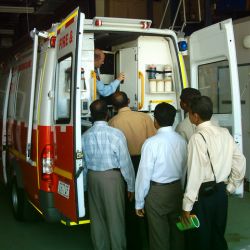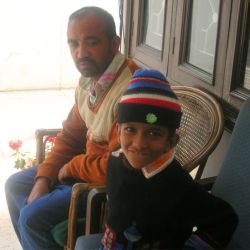Setting the Foundation for success
Success! Your request has been sent and a representative will be in contact soon.
An AMA Queensland Foundation history flashback.
On 1 July 2000, the cusp of a new century, AMA Queensland launched our charity arm, the AMA Queensland Foundation. For anyone over 40, it is humbling to grasp that the year 2000 was in fact, 25 years ago. While Y2K earmarked what would be a new technological area, at the time, the world was still quite “hands-on” in comparison to today’s standards. We didn’t have cameras strapped to us 24/7 as we do today, and many of AMA Queensland’s publications were not yet available in an online format.
To go back to where it all started, we needed to pick the brain of someone who was there in the beginning. Who better to talk to, than our own Neil Mackintosh, the ‘founding father’ of the Foundation’s back-end operations, known to so many of our current and past supporters. Neil began his role at AMA Queensland on the first working day in January 2000, on a six-month contract to help with rolling out G.S.T. training seminars to doctors. Neil would dedicate the next 20 years to AMA Queensland and the AMA Queensland Foundation in various roles until his retirement in 2020.
We hope you enjoy our trip down memory lane with him, to learn about the early days of the Foundation, and some of the important projects that cemented our mission of Doctors Doing Good.
Banner image above: AMAQ Foundation Executive Officer Neil Mackintosh with Deputy Principle Kate Russ from Red Hill Special School taken in 2009, after fundraising efforts helped the school purchase specialised equipment for students.
Establishing a charity
AMA Queensland Foundation was formally established on 1 July 2000, by the CEO of the day, Kerry Gallagher, who put together a Board. He tasked Neil with ensuring Australian Tax Office (ATO) approval.
“A lot of hard work went into establishing the Foundation as a Public Benevolent Institution with Deductible Gift Recipient status,” Neil remembers.
A constitution was drawn up by one of the Board Members and some seed funding was provided by the visiting medical officer’s salary sacrifice fund.
“Fundraising commenced with direct campaigns to [AMA Queensland] members, mainly by mail in those days,” Neil said.
He recalls the priority in the early days was to introduce doctors to the Foundation, as well as securing sponsorship from companies directly connected to the medical profession.
Over the years that followed, the Foundation set up several fundraising events for medical professionals and friends. Neil remembers with fondness the golf Days, gala dinners, and a fashion parade or two at the Myer Centre. These events greatly contributed to raising money for AMA Queensland Foundation causes.
Support for medical students
Neil says the initial focus of the Foundation was to provide enhanced medical access for rural and remote people. This also sparked the beginnings of Medical Student Scholarships, which is still a central focus of our fundraising and support.
Now open to all of Queensland, initially, scholarships were restricted to Townsville’s James Cook University students, to help promote rural doctor placements.
“The idea was, if students came from the bush, they were more likely to go back to the bush and work, and on that issue, the very first scholarship holder from way back when, is still practicing in the bush,” Neil said.
Dr Emily Vagg, our first scholarship recipient, is former Director of Medical Services in Ingham and is currently serving the Palm Island community and surrounds as a rural generalist.
The Foundation continues to support rural medical students, with a significant number of Medical Student Scholarship recipients still coming from rural and remote parts of Queensland.
A helping hand in times of disaster
Neil said there were many aspects of working on behalf of AMA Queensland Foundation that he was particularly proud of. One significant project was the support the Foundation provided after the Boxing Day Tsunami in 2004.
“We took out a full-page ad in the Courier Mail advertising for help to supply direct medical support to countries affected by the tsunami. In about one week, we had raised $60,000,” he said.
 With such overwhelming support, Neil says it was important the money was used in the right way. Connections on the ground in Sri Lanka, an area particularly devastated, was decided as the most appropriate place to provide support that could directly benefit those in need. The Board decided to bring Sri Lankan health professionals to Australia to upskill them.
With such overwhelming support, Neil says it was important the money was used in the right way. Connections on the ground in Sri Lanka, an area particularly devastated, was decided as the most appropriate place to provide support that could directly benefit those in need. The Board decided to bring Sri Lankan health professionals to Australia to upskill them.
“We brought three groups of doctors and public health inspectors [to Australia] and they were provided with advanced first aid training, first responder skills and disaster relief management,” he said.
This had a lasting impact not only through the aftermath of the tsunami, but in the years to follow.
Pictured: Sri Lankan medical professionals undergoing training in first responder skills in 2004.
Providing lifesaving medical help in India
In 2007, ABC’s Foreign Correspondent were conducting a story on the ground in an Indian hospital. The story showcased the grim state of public hospitals in the country, against the backdrop of a private hospital system that was seeing an increased number of Australian patients for elective plastic surgery.
While panning around the crowded waiting room, the camera crew stopped on a young boy waiting with his father, Ram. Six-year-old Inderjit Swarup was born with his bowel protruding through his stomach wall, and desperately needed medical treatment.
While in the developed world, Inderjit’s condition would have been fixed with surgery, in India, Ram had been trying for six years to get his son the help he needed. The young boy had gone through four operations and continued to suffer.
It was suggested that AMA Queensland Foundation could help.
 “We raised funds via direct campaign to our members and the funds provided direct payment to medical specialists in India. We were able to channel that money through a locally engaged employee at the Australian Embassy and he made sure the money went direct to the doctors who were treating him. This was really important, and it resulted in a full recovery for Inderjit,” Neil said.
“We raised funds via direct campaign to our members and the funds provided direct payment to medical specialists in India. We were able to channel that money through a locally engaged employee at the Australian Embassy and he made sure the money went direct to the doctors who were treating him. This was really important, and it resulted in a full recovery for Inderjit,” Neil said.
A follow up segment by Foreign Correspondent, titled Whatever Happened to Inderjit showcased the project’s success, showing a happy Inderjit playing cricket in the streets, and going to school.
On the way back from the 2007 AMA Queensland Annual Conference in Istanbul, Neil was able to stop in India and set up a visit with Inderjit and Ram.
“Inderjit was doing really well, and it was absolutely heartwarming to see the guy in person…he was a shy little fella, and of course, he was a bit overwhelmed by these foreigners coming into his house,” Neil said.
Pictured above: Ram and Inderjit Swarup, 2008
Thank you, Neil!
By 2010, Neil had moved away from AMA Queensland Foundation work, to focus on planning and conduct for the AMA Queensland Annual Conferences. He enjoyed this role until his retirement in 2020.
As the Foundation celebrates 25 years, we wish to acknowledge Neil’s time and dedication to AMA Queensland Foundation’s success. We know he continues to be a big supporter of our efforts, and we thank him sincerely for his service to the cause of improving health outcomes for those in need.

